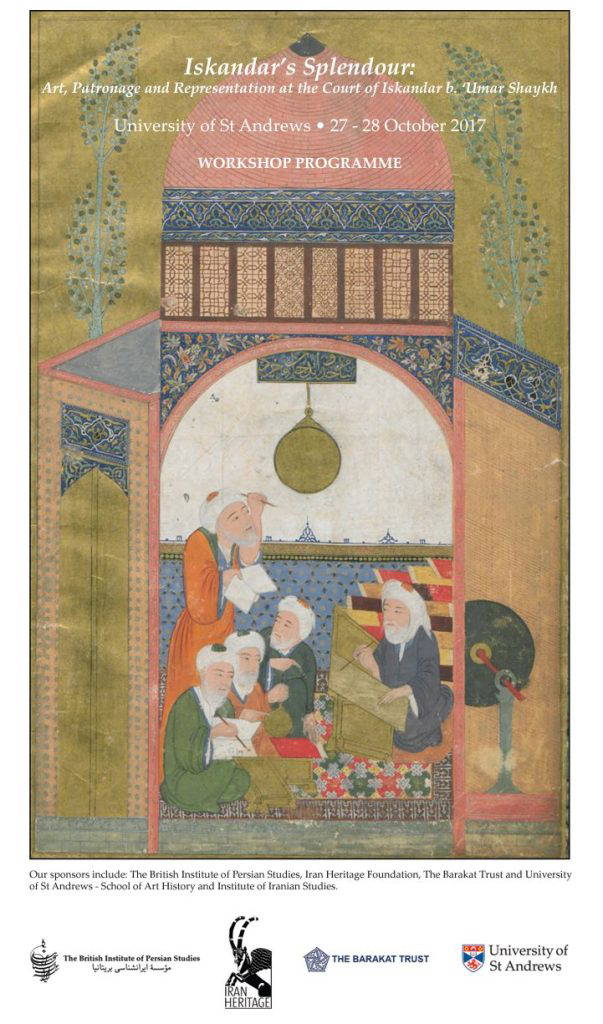April 2017 | BIPS Research Grant
 The two-day workshop Iskandar’s Splendour was convened as part of the British Institute of Persian Studies’ Medieval Research Programme, whose focusses on material culture, religion, philosophy and literature this workshop and the therefrom evolving project share. Within this larger scope, the workshop has zoomed in on effectively five years of Iranian history and created room to discuss the architecture, art, literature and science produced during the reign of the Timurid prince Iskandar b. ʿUmar Shaykh in Shiraz (1409-12) and Isfahan (1412-14). The valued sponsorship of the British Institute of Persian Studies has allowed nine scholars from Europe and the US to come together in St Andrews, to present their research and engage in scholarly exchange amongst each other and with Scotland-based academics and students.
The two-day workshop Iskandar’s Splendour was convened as part of the British Institute of Persian Studies’ Medieval Research Programme, whose focusses on material culture, religion, philosophy and literature this workshop and the therefrom evolving project share. Within this larger scope, the workshop has zoomed in on effectively five years of Iranian history and created room to discuss the architecture, art, literature and science produced during the reign of the Timurid prince Iskandar b. ʿUmar Shaykh in Shiraz (1409-12) and Isfahan (1412-14). The valued sponsorship of the British Institute of Persian Studies has allowed nine scholars from Europe and the US to come together in St Andrews, to present their research and engage in scholarly exchange amongst each other and with Scotland-based academics and students.
The idea for this workshop arose from the wealth of the available material, which calls for study by scholars from various disciplines. Although Iskandar is well-known amongst historians of art, literature, politics and science, the corpus of works produced during his reign has hitherto not been collected, let alone studied, in its entirety. The workshop therefore aimed to publicise newly discovered material and to discuss and evaluate approaches and open questions. Remarked by one of the speakers and confirmed by the other speakers and participants of the workshop, this has been the first event on a single Timurid princely figure. We thank it to the maturity of study, to the generosity of the sponsors and to the University of St Andrews that such a specialised workshop could take place.
This specialist character and the many open questions still to be discussed were the reasons to design this event as a workshop instead of a formal conference. The workshop was opened by Dr Tim Greenwood, Director of the Institute of Iranian Studies, University of St Andrews, who underscored the importance of convening focussed workshops and the necessity for the publication of their outcomes. The framework of the workshop itself consisted of five thematic sessions of presentations of twenty minutes, which were followed by ten-minute discussions (please see the attached programme for more details). In many ways, the presentations have not only met but even surpassed the expectations; Thrilling new material was presented and participants generously shared their original views, insights and queries. The friendly and open atmosphere allowed for lively exchange after the talks, during breaks and dinners, and, especially, in the final discussion-session. The latter was based on discussion questions and topics that the speakers had formulated prior to the workshop, as well as on those that came up during the two days of intense engagement with Iskandarid material. In this immensely fruitful session, we amongst others debated about the concept of patronage, names and titles of Iskandar, relationships to the Jalayirid dynasty and the legacy of the production of art and written works under Iskandar in later Timurid history. Discussing approaches to this abundant material, the workshop’s speakers unanimously agreed on continuing this project, which will be dealt with at the end of this report.
Unexpected challenges consisted of cancellations by speakers, who, against their wishes, were unable to attend. Dr Ali Shojaee Esfahani from the Art University of Isfahan did not receive his visa on time, but generously sent a pre-recorded presentation which we played during the workshop. Very unfortunate, Dr Karin Rührdanz had to cancel due to health reasons. She kindly sent here presentation and paper, which was read by Dr Ilse Sturkenboom. Both Dr Karin Rührdanz and Dr Ali Shojaee Esfahani received questions after their presentations by telephone.
Another unexpected but very welcome occasion was the offer of Mrs Fatemeh Khansalar to display art works by herself and the Shiraz-based Goleaan group of Iranian miniaturist. Their lacquer painted objects brought even more aesthetics and colour to our workshop.
Bringing together scholars to discuss the artistic and intellectual output of Iskandar’s reign has had a synergetic effect. The knowledge and insights presented often seamlessly connected one presentation to another, and one scholar’s approaches also proved to be valuable for others. Through this cooperation we all gained a better understanding of Iskandar and his time. As mentioned earlier, the unanimous consent is that this knowledge should not go to waste. We decided to work together in producing an edited volume that beyond publishing the results of this workshop should form a comprehensive handbook for all those seeking to grasp aspects of Iskandar’s courtly life. In order to achieve such a comprehensive book, some speakers committed to publish on a topic deviating from their presentations and further scholars who were not present are and will be asked to contribute. Working towards this publication, we stay in contact through the online platform ‘Iskandar Circle’ which allows for further exchange of knowledge, ideas and material.
We remain grateful to the British Institute of Persian Studies for enabling this workshop and for significantly contributing to its success.